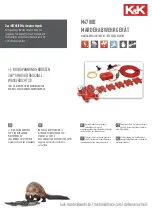
Watlow PM LEGACY™ Limit Controller
•
41
•
Chapter 4 Home Page
ber represents the enumerated value for that particular selection. Range selections can be made sim-
ply by writing the enumerated value of choice using any of the available communications protocols. As
an example, turn to the Setup Page and look at the Analog Input
Ai
menu and then the Sensor Type
sEn
prompt. To turn the sensor off using Modbus simply write the value of 62 (off) to register.
Communication Protocols
When using a communications protocol in conjunction with the PM LEGACY™ Limit there are two
possible ports (instances) used. Port 1 or instance 1 is always dedicated to Standard Bus
communi-
cations. This same instance can also be used for Modbus RTU if ordered. Depending on the control-
ler part number, port 2 (instance 2) can be used with Modbus, CIP and Profibus. For further informa-
tion read through the remainder of this section.
Modbus Introduction to the Modbus Protocol
Gould Modicon, now called AEG Schneider, first created the protocol referred to as “Modbus RTU”
used in process control systems. Modbus provides the advantage of being extremely reliable in ex-
changing information, a highly desirable feature for industrial data communications. This protocol
works on the principle of packet exchanges. The packet contains the address of the controller to re-
ceive the information, a command field that says what is to be done with the information, and several
fields of data. Each PM parameter has a unique Modbus address and they can be found in the follow-
ing Operations, Setup and Factory Pages.
All Modbus registers are 16-bits and as displayed in this User’s Guide are relative addresses (actual).
For parameters listed as float, notice that only one (low order) of the two registers is listed; this is true
throughout this document. By default, the low order word contains the two low bytes of the 32-bit pa-
rameter. As an example, look in the Operations Page under the Analog Input Menu for the Analog In-
put Value. Find the column identified in the header as Modbus and notice that it lists register. Because
this parameter is a float it is actually represented by registers (low order bytes) and (high order bytes).
The Modbus specification does not dictate which register should be high or low order therefore,
Watlow provides the user the ability to swap this order (Setup Page,
CoЛЏ
Menu) from the default
low/high
Lohi
to high/low
hiLo
.
Note:
Notice in the column identified as Modbus the reference to Map 1 and Map 2 registers for each of
the various parameters. For all new applications, select Modbus Map 2 and use Map 2 listed values.
For backwards comparability with older PMs, use Modbus Map 1 if needed. If the new functions of
this product line are not to be used, Map 1 (LEGACY™ PM controls) Modbus registers will be suf-
ficient. The Modbus register mapping
Map
can be changed in the Setup Page under the
CoM
Menu.
This setting will apply across the control. We recommend using Map 2 for all new applications. Use
Map 1 only if it is desired to maintain backwards compatibility.
It should also be noted that some of the cells in the Modbus column contain wording pertaining to
an offset. Several parameters in the control contain more than one instance, such as, alarms (4). The
Modbus register shown always represents instance one. Take for an example the Silence Alarm pa-
rameter found in the Setup Page under the Alarm Menu. Instance one of Map 1 is shown as address
1490 and +50 is identified as the offset to the next instance. If there was a desire to read or write to
instance 3, simply add 100 to 1490 to find its address, in this case, the instance 3 address for Silence
Alarm is 1590.
The Modbus communications instance can be either 1 or 2 depending on the part number.
Instance 1:
















































